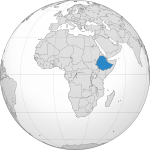Overview
About eight million people in Ethiopia are in need of humanitarian assistance, largely as a consequence of internal conflict, international displacement, and recurrent natural hazards.? Intercommunal violence escalated dramatically in several regions throughout 2018, resulting in more than 1.3 million new displacements and increasing Ethiopia’s total IDP population to 2.4 million.? Ethiopia also hosts more than 900,000 refugees.? Over 99% of the refugees come from four neighbouring countries: South Sudan, Sudan, Somalia, and Eritrea, and most currently reside in camp settings.?
Humanitarian needs in Ethiopia are significantly impacted by recurrent natural hazards, in particular drought and flooding. Several consecutive years of drought in southern and southeastern Ethiopia have led to worsening food security and disrupted the livelihoods of hundreds of thousands of farmers and herders. Nearly all of Somali regional state, one of the regions most affected by food insecurity, is in IPC Phase 2 (Stressed) and IPC Phase 3 (Crisis).? Nationwide, approximately 7.88 million people continue to require emergency food assistance.?
INFORM measures Ethiopia's risk of humanitarian crisis and disaster as high at 6.9/10. Lack of coping capacity is of particular concern at 7.7/10.?
Latest Developments
19/06/2020: The first COVID-19 case has been diagnosed in the Adi-Harush refugee camp and admitted to a government hospital. The camp hosts about 33,000 Eritrean refugees. Ethiopian authorities are trying to equip all 26 camps with medical, hygiene, and water facilities to mitigate virus spread. Ethiopia reports 3,954 cases of COVID-19 cases with 65 deaths as of 19 June.?
26/05/2020: An outbreak of Dracunculiasis (Guinea worm disease) was reported in Gog district of Ethiopia's Gambella region. Seven cases were reported (no fatalities). Spread of the parasitic disease through contaminated drinking water sources is increasing the risk of more infections. Rural and isolated communities are most vulnerable because they lack safe water sources, are hard to reach, and have large refugee influxes. Regular cross-border movements between Ethiopia and South Sudan creates risk of international spread. The Ethiopian Dracunculiasis Eradication Program (EDAP) and the WHO are providing emergency assistance and education on disease prevention.?
ACAPS' team is daily monitoring the impact of COVID-19. Find more information related to the outbreak here.
Key Figures
INFORM Global Crisis Severity Index
Crisis Severity: 3.9
Impact: 3.5
Humanitarian Conditions: 4.5
Complexity: 3.3
Access Constraints: 3
Information courtesy of ACAPS. https://www.acaps.org/
| Title | Uploaded |
|---|---|
| SMS Coordination Group – Gedeo and West Gudji - Terms of Reference | 01 Jan 2018 |
15 Common Operating Datasets or CCCM-tagged datsets are on the Humanitarian Data Exchange:
- Ethiopia Displacement -IDPs - Site Assessment [IOM DTM] - International Organization for Migration (IOM) - 02/01/2020-02/29/2020
- Ethiopia administrative level 0-3 population statistics - Central Statistics Agency (CSA), Regional Bureau of Finance and Economic Development (BoFED), Federal Ministry of Health - 10/01/2019
- Ethiopia administrative level 0-3 boundaries - CSA (Central Statistics Agency) + Regional Bureau of Finance and Economic Development (BoFED) - 09/04/2019
- Ethiopia Displacement Data - Geodeo and West-Guji - RRA [IOM DTM] - International Organization for Migration (IOM) - 08/11/2019-08/23/2019

